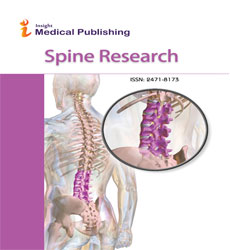Scoliosis in Adolescents: Modern Diagnostic and Surgical Strategies
Mira Ahmad
Published Date: 2025-02-28Mira Ahmad*
Department of Anesthesiology, Eye & ENT Hospital of Fudan University, Shanghai 200031, China
*Corresponding author:
Mira Ahmad,
Department of Anesthesiology, Eye & ENT Hospital of Fudan University, Shanghai 200031, China,
E-mail: ahmad.mira@eentanesthesia.com
Received date: February 01, 2025, Manuscript No. ipsr-25-20627; Editor assigned date: February 03, 2025, PreQC No. ipsr-25-20627 (PQ); Reviewed date: February 15, 2025, QC No. ipsr-25-20627; Revised date: February 22, 2025, Manuscript No. ipsr-25-20627 (R); Published date: February 28, 2025, DOI: 10.36648/ 2471-8173.11.1.04
Citation: Ahmad M (2025) Scoliosis in Adolescents: Modern Diagnostic and Surgical Strategies. Spine Res Vol.11 No.1:04
Introduction
Scoliosis is a three-dimensional deformity of the spine characterized by lateral curvature and vertebral rotation, commonly developing during adolescence. Adolescent Idiopathic Scoliosis (AIS) is the most prevalent form, affecting 2â??4% of children between ages 10 and 18, with a higher incidence in females. While mild curves are often asymptomatic, progressive scoliosis can lead to physical deformity, back pain, cardiopulmonary compromise and psychosocial issues. Early diagnosis and accurate assessment of curve progression are crucial for optimizing treatment outcomes. Advances in imaging, bracing technology and surgical techniques have significantly improved the management of adolescent scoliosis, enabling personalized interventions that correct deformity, preserve spinal function and enhance quality of life. Understanding the pathophysiology, natural history and biomechanical implications of scoliosis is essential for guiding contemporary diagnostic and therapeutic strategies [1].
Description
The etiology of adolescent scoliosis remains multifactorial, with genetic, biomechanical and environmental factors contributing to curve development. Idiopathic scoliosis, accounting for the majority of adolescent cases, is thought to involve abnormalities in spinal growth regulation, neuromuscular control and connective tissue integrity. Research indicates a potential role of genetic predisposition, with mutations in genes associated with skeletal development, extracellular matrix components and growth hormone signaling. Biomechanical factors, including asymmetrical vertebral loading and muscular imbalances, may exacerbate curve progression during rapid growth phases. Hormonal influences and neuromuscular asymmetry are also implicated in curve pathogenesis, reflecting the complex interplay of systemic and local factors in AIS development [2]. Diagnosis of scoliosis in adolescents begins with a thorough clinical evaluation. Observation of spinal alignment, shoulder and hip symmetry and the presence of rib humps or trunk rotation is essential. The Adamâ??s forward bend test is widely used as a screening tool, enabling detection of rib prominence indicative of spinal rotation. Confirmatory imaging is critical for accurate diagnosis and assessment of curve magnitude. Conventional radiographs remain the gold standard, with standing posteroanterior and lateral views providing measurement of the Cobb angle, vertebral rotation and sagittal profile. Curve severity, skeletal maturity and growth potential guide treatment planning. Advanced imaging modalities, including low-dose EOS imaging and Magnetic Resonance Imaging (MRI), provide detailed three-dimensional assessment of the spine while minimizing radiation exposure. MRI is particularly useful for detecting underlying intraspinal anomalies, such as tethered cord, syringomyelia, or spinal cord tumors, which may influence management decisions [1].
Non-surgical management is indicated for mild to moderate curves, particularly in skeletally immature patients. Bracing remains the cornerstone of conservative treatment, aiming to halt curve progression during periods of rapid growth. Modern brace designs, including ThoracoLumboSacral Orthoses (TLSO) and custom-fitted three-dimensional braces, optimize corrective forces while improving patient comfort and compliance. Recent innovations incorporate CAD/CAM technology, sensor-based monitoring and adjustable tension systems to personalize bracing and maximize efficacy. Physical therapy, postural exercises and core strengthening complement bracing by improving spinal alignment, muscular balance and functional capacity. Early detection and adherence to conservative interventions are associated with reduced need for surgical correction and improved long-term outcomes.
Surgical intervention is indicated for severe curves, typically greater than 45â??50 degrees, progressive deformities, or those associated with functional compromise.
The primary goals of surgery are curve correction, spinal stabilization and preservation of mobility. Posterior Spinal Fusion (PSF) with segmental instrumentation is the most commonly performed procedure, involving the placement of pedicle screws and rods to correct deformity and achieve fusion of affected vertebral segments. Modern instrumentation techniques allow three-dimensional correction of coronal, sagittal and rotational deformities while minimizing complications. Anterior spinal fusion, less commonly used, provides direct disc access and is indicated for specific curve patterns, particularly thoracolumbar and lumbar curves.
Conclusion
Adolescent scoliosis is a complex spinal deformity with significant implications for physical function, aesthetics and quality of life. Modern diagnostic approaches, including advanced imaging, three-dimensional assessment and biomechanical evaluation, facilitate early detection, accurate characterization and risk stratification of curve progression. Non-surgical interventions, such as bracing and targeted physiotherapy, remain effective for mild to moderate curves, particularly in skeletally immature patients. Surgical strategies, including posterior and anterior spinal fusion, minimally invasive approaches and growth modulation techniques, provide durable correction and stabilization for severe or progressive deformities. Innovations in navigation, robotics and intraoperative monitoring have improved safety, precision and outcomes. Future directions emphasize regenerative therapies, personalized treatment planning and minimally invasive interventions that preserve mobility while controlling deformity. An integrated, multidisciplinary approach encompassing early diagnosis, individualized management and postoperative rehabilitation is essential for optimizing functional recovery and long-term spinal health in adolescents with scoliosis.
Acknowledgement
None.
Conflict of Interest
None.
References
- Siepe CJ, Zelenkov P, Sauri-Barraza JC, Szeimies U, Grubinger T, et (2010) The fate of facet joint and adjacent level disc degeneration following total lumbar disc replacement: a prospective clinical, X-ray, and magnetic resonance imaging investigation. Spine (Phila Pa 1976) 35: 1991-2003.
Google Scholar Cross Ref Indexed at
- Baur-Melnyk A, Birkenmaier C, Reiser MF (2006) Lumbar disc arthroplasty: Indications, biomechanics, types, and radiological criteria. Radiologe 46: 770-778.
Open Access Journals
- Aquaculture & Veterinary Science
- Chemistry & Chemical Sciences
- Clinical Sciences
- Engineering
- General Science
- Genetics & Molecular Biology
- Health Care & Nursing
- Immunology & Microbiology
- Materials Science
- Mathematics & Physics
- Medical Sciences
- Neurology & Psychiatry
- Oncology & Cancer Science
- Pharmaceutical Sciences
